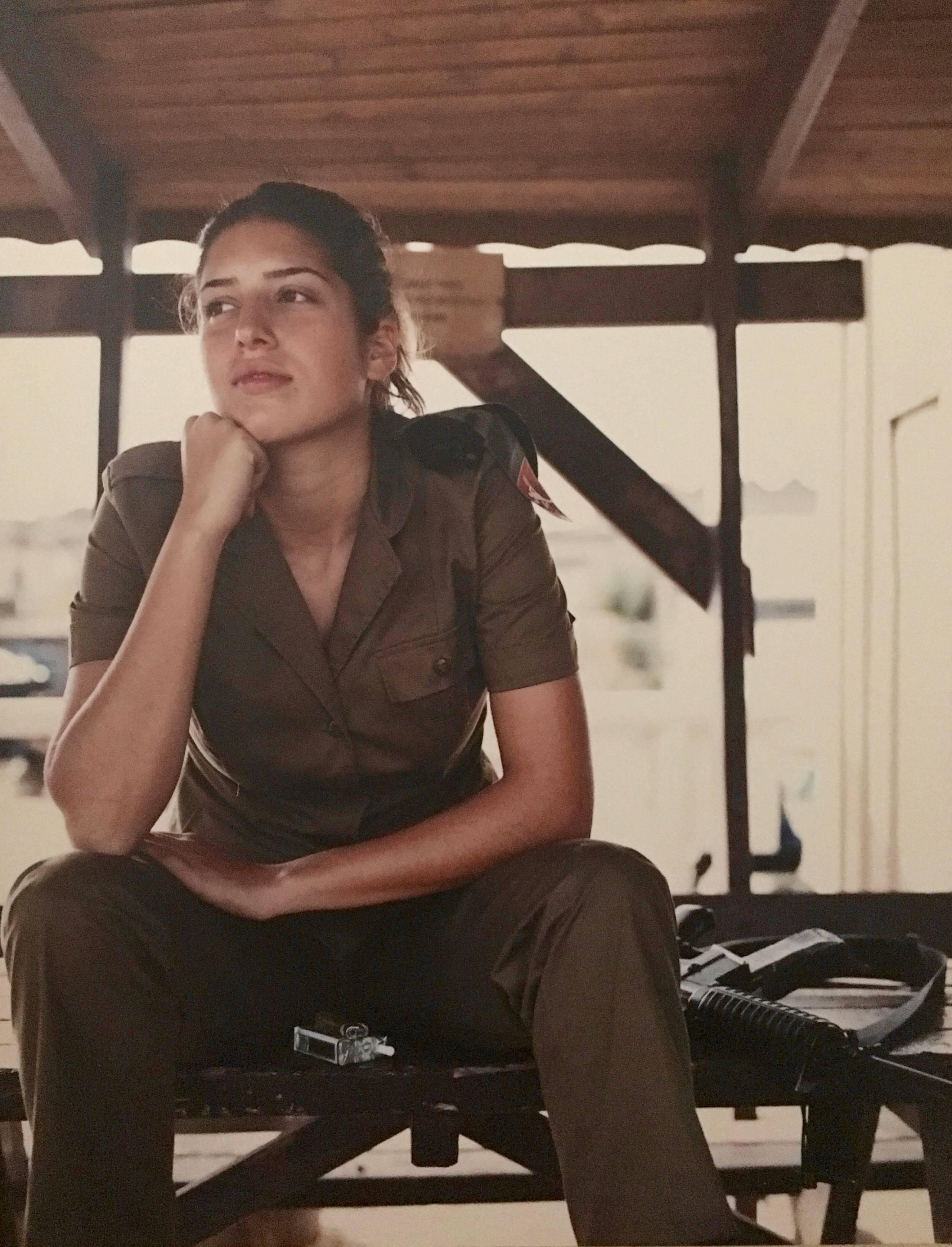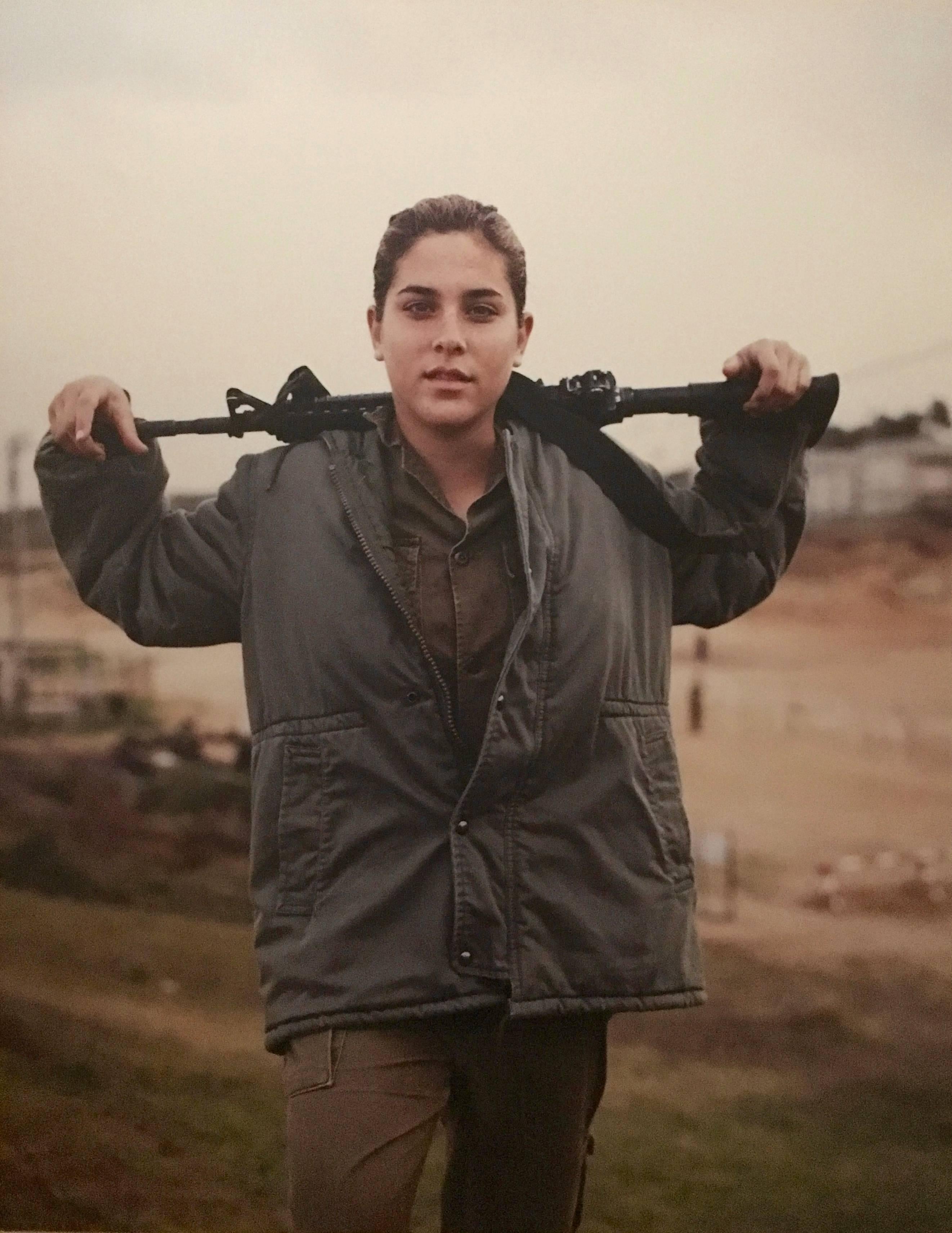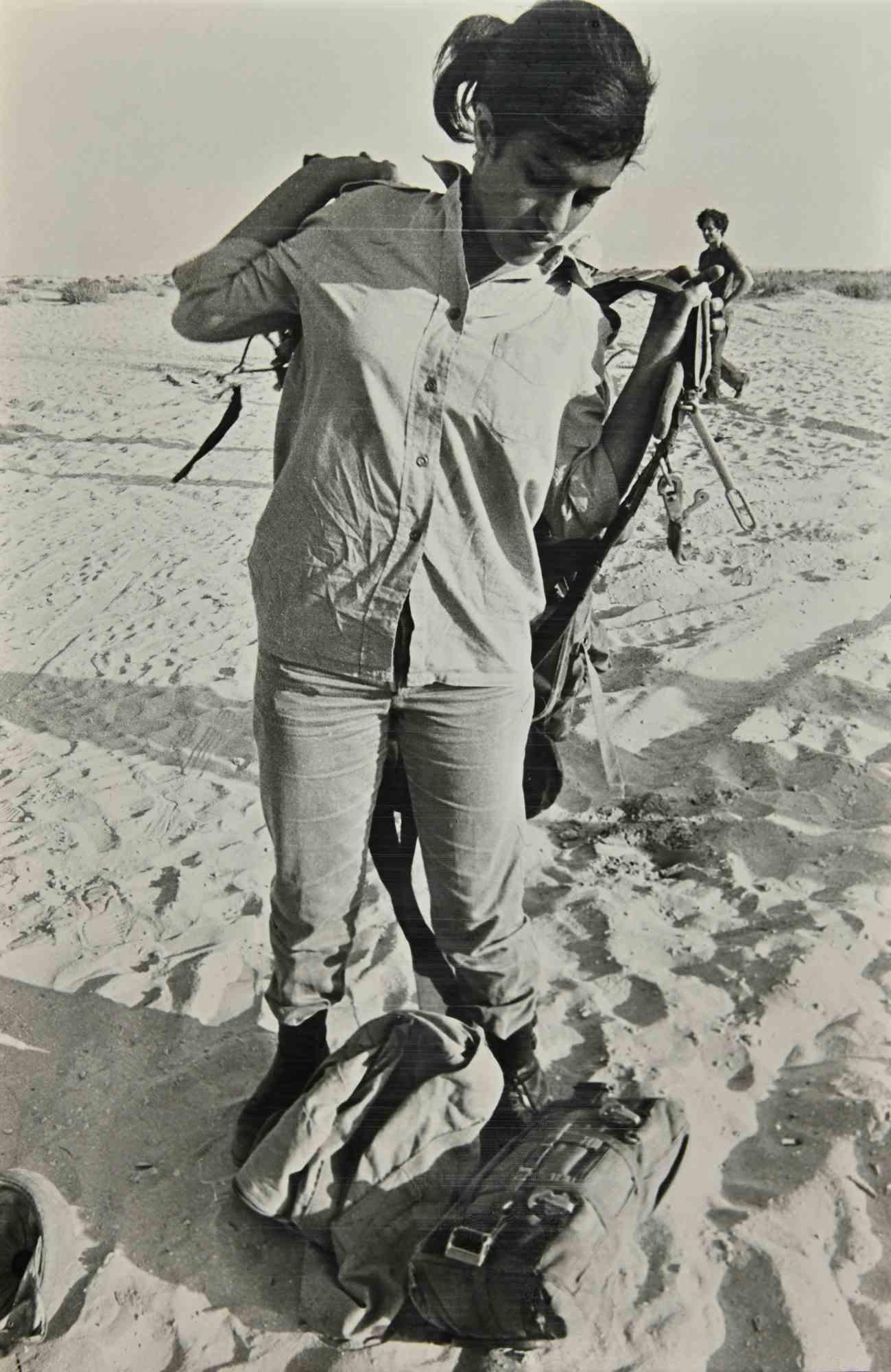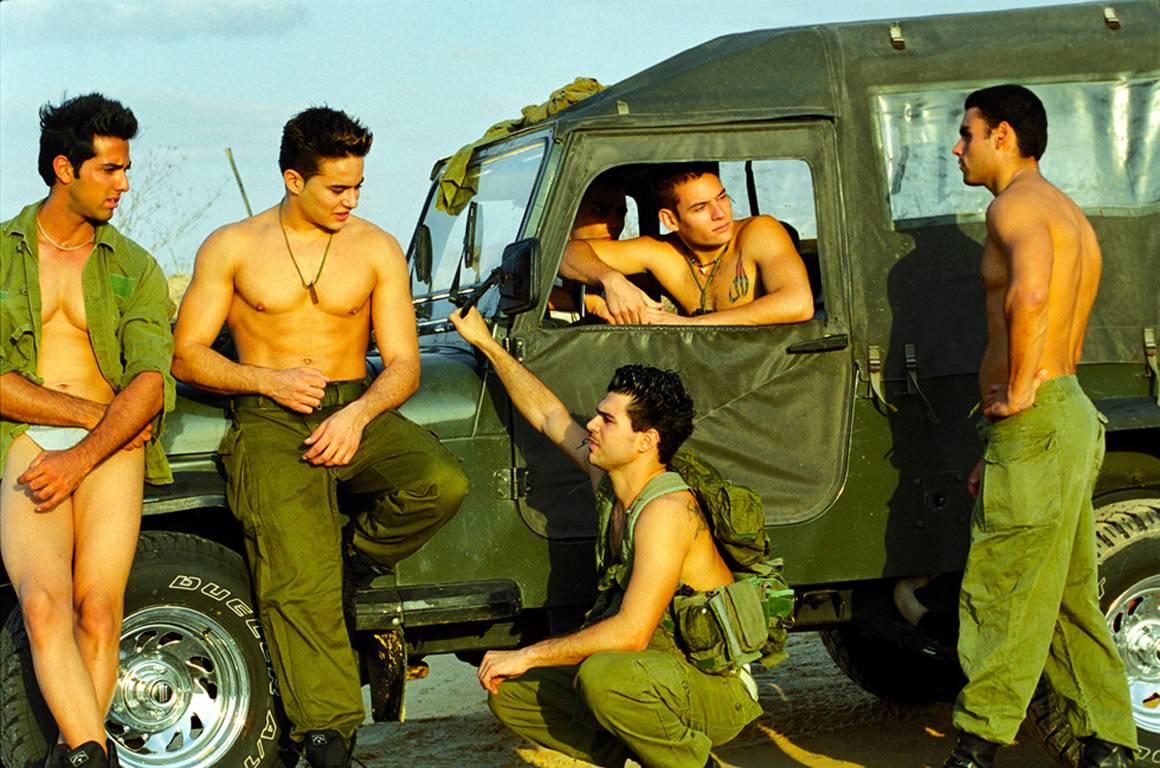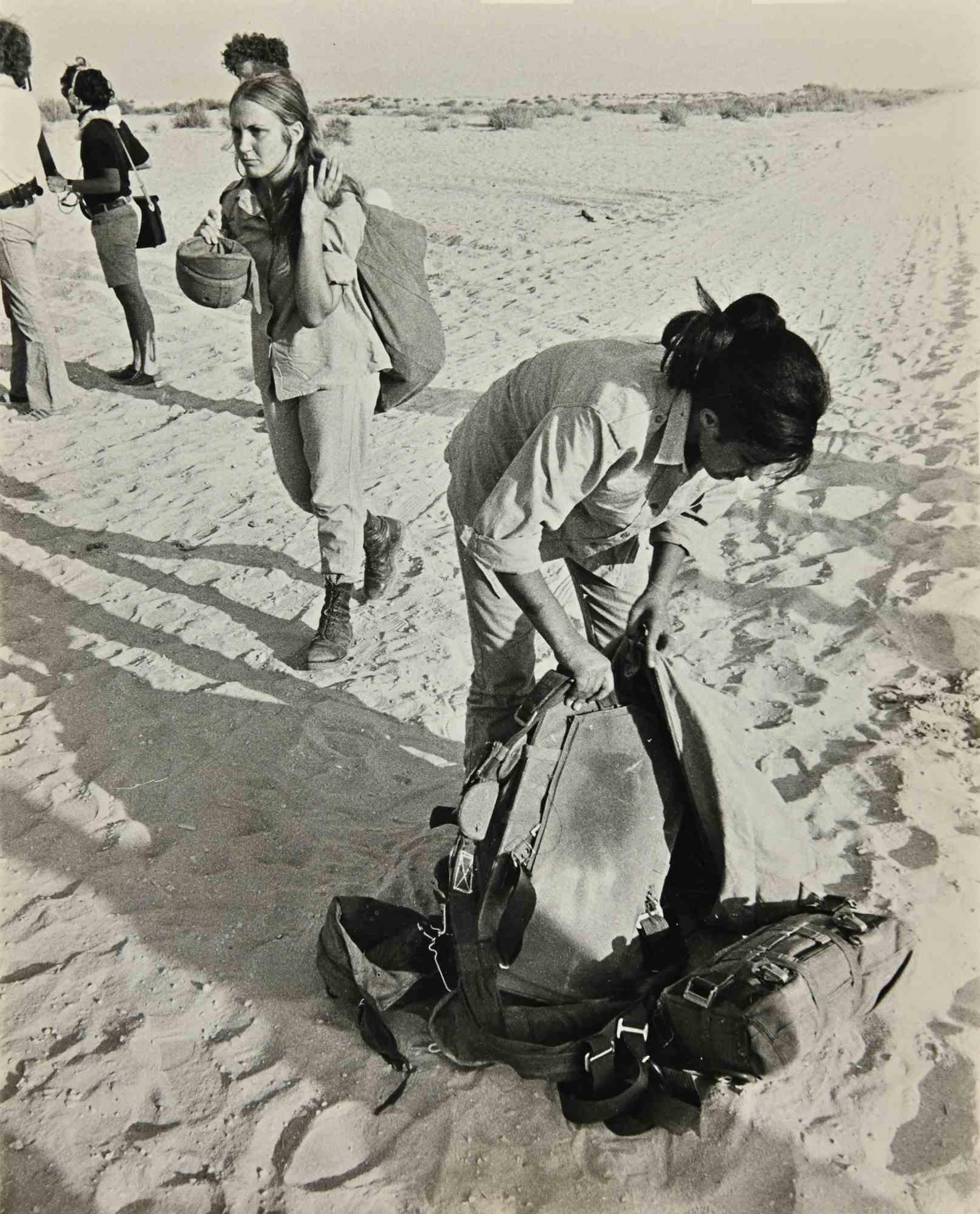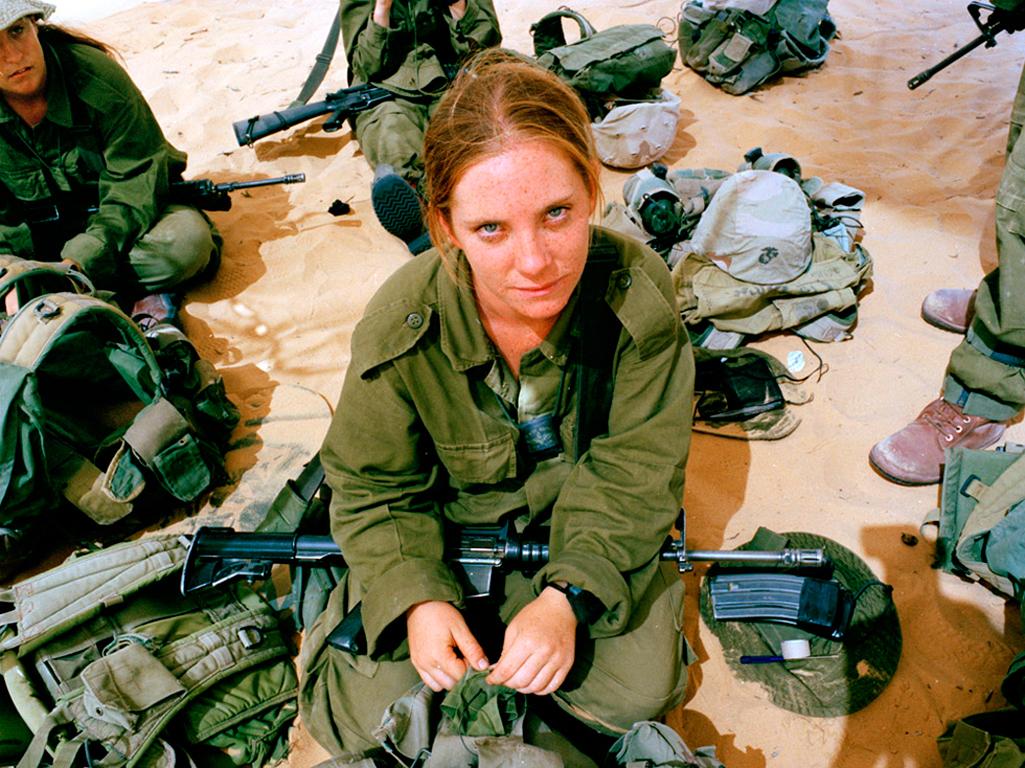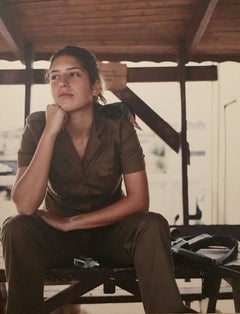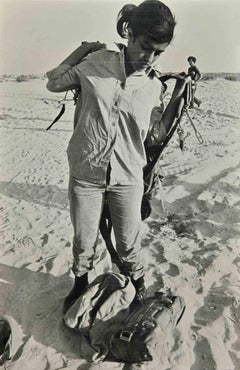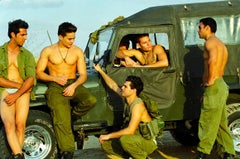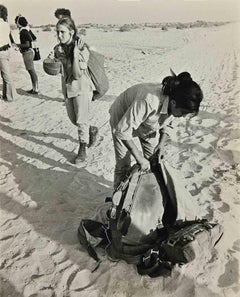Items Similar to WOMEN OF THE ISRAEL DEFENSE FORCES Large Photo NETA
Want more images or videos?
Request additional images or videos from the seller
1 of 8
Ashkan SahihiWOMEN OF THE ISRAEL DEFENSE FORCES Large Photo NETA
$1,800
£1,365.80
€1,561.67
CA$2,514.11
A$2,795.35
CHF 1,459.58
MX$34,026.22
NOK 18,623.58
SEK 17,449.40
DKK 11,655.02
Shipping
Retrieving quote...The 1stDibs Promise:
Authenticity Guarantee,
Money-Back Guarantee,
24-Hour Cancellation
About the Item
"Women of the IDF" Large Exhibition color Photograph
30 x 40 inches, mounted on masonite and laminated.
Edition of 4 + 2 artists proof. minor dings and bumps to edges Born in Tehran, Iran, Ashkan Sahihi moved with his family to West Germany at the age of seven. Although he began taking photographs as a teenager, Sahihi traces the beginning of his professional trajectory to New York in 1987, a thriving “pop culture metropolis” where he could do the kind of photography work that he wanted to do, exploring the underbelly of the society around him. Taking assignments from German publications such as the Süddeutsche Zeitung Magazine, Der Spiegel, Dummy and GEO, he photographed subjects like prisoners on death row, players in the hip-hop scene, and the downtown art scene of New York. Neither black nor white, an insider among outsiders, he found himself able to navigate spaces and dynamics that others might have had difficulty entering. He considered this both a privilege and an obligation – to visit these places and tell these stories. His success led to commissions from American publications as well, including the New York Times Magazine, the New Yorker, Rolling Stone, and Vogue.
Put off by the limitations of photojournalism (the expectation that he would illustrate the writer’s perspective rather than author a narrative of his own), Sahihi began to embark on independent, highly compact conceptual series. His main goal in these series has been to drive forward public discourse on topics he believes have not provoked enough or the right kind of discussion: drugs, gender in the media, women in the military, etc. His portraits draw on a familiar visual language – often seated subjects before a neutral backdrop – but push the viewer to feel and think about entirely new things. Although he constantly challenges the comfort level of both the viewer and the subject, Sahihi never removes himself from the line of fire; all of his work requires the artist to immerse himself in uncomfortable situations and challenge his own emotional fortitude.
Photographic Series
In the “Face Series”, latex-gloved hands manipulate the subjects’ features, stretching, pushing, squeezing, pinching at the whim of external direction – from the artist? The customer? The public? The “Hypnosis Series” comprises 8 portraits of hypnotized subjects each experiencing a single emotion, e.g. helplessness, withholding/anger, or regret. In a society that rewards the suppression of such naked emotion, the purity of these depictions is arresting.
In 2006, Sahihi photographed himself in the homes and with the families of six ex-girlfriends and one ex-wife, imposing himself more or less awkwardly on the constellations that emerged after he had exited their lives (“Exes Series”).
For Sahihi’s most well-known work, the “Drug Series,” he convinced 11 non–drug users to consume a particular drug, then took their portraits over the course of their trips. The series was born out of Sahihi’s frustration with the hypocrisy of the political conversation about drugs in the United States. “By attempting to present an objective image of drug use, the artist addresses the cultural politics that allow our society to simultaneously glamorize the ‘drug look’ in fashion magazines and the entertainment industry and meanwhile turn a blind eye to the complicated, and vast, problem of drug abuse.” Sahihi has exhibited this series at MoMA PS1 New York in 2001, in Dresden in 2008, and alongside his installation “100 Million in Ready Cash."
Sahihi’s dense explorations through small photographic series include “Women of the IDF," portraits of female Israeli soldiers; “Camp X-Ray Guantanamo Bay,” black-and-white landscapes of barbed wire and watch towers; the “Cum Series”; the “Armpit Series”; and the “Kiss Series," in which the artist photographed himself kissing 18 women and men of various ethnicities. Sahihi’s photographs of the Occupy Wall Street movement constitute his latest series of this kind.
In recent years, Sahihi has lived and worked in New York, Istanbul, the Middle East, and London, producing bodies of work in each place that attempt to engage the political discourse he deems lacking in substance.
Exhibitions
Andrea Rosen Gallery, NY, USA (2000)
Basel Art Fair 31, Switzerland (2000)
MoMA PS1, NY, USA (solo and group shows, 2001 and 2006)
John Connelly Presents, NY, USA
Akureyri Museum, Iceland
Akademie der Künste, Berlin, Germany
Axel Raben Gallery, NY, USA
Macro, Rome, Italy
Schloss Morsbroich, Leverkusen, Germany
Städtische Galerie, Dresden, Germany
Galerie am Körnerpark, Berlin, Germany (2015)
Galerie Springer, Berlin, Germany (2015)
Kehrer Galerie, Berlin, Germany (2016)
- Creator:Ashkan Sahihi (1963, Iranian)
- Dimensions:Height: 40 in (101.6 cm)Width: 31 in (78.74 cm)Depth: 1 in (2.54 cm)
- Medium:
- Period:
- Condition:minor bumps and and dents to edges.
- Gallery Location:Surfside, FL
- Reference Number:1stDibs: LU38211256722
About the Seller
4.9
Platinum Seller
Premium sellers with a 4.7+ rating and 24-hour response times
Established in 1995
1stDibs seller since 2014
1,784 sales on 1stDibs
Typical response time: <1 hour
- ShippingRetrieving quote...Shipping from: Surfside, FL
- Return Policy
Authenticity Guarantee
In the unlikely event there’s an issue with an item’s authenticity, contact us within 1 year for a full refund. DetailsMoney-Back Guarantee
If your item is not as described, is damaged in transit, or does not arrive, contact us within 7 days for a full refund. Details24-Hour Cancellation
You have a 24-hour grace period in which to reconsider your purchase, with no questions asked.Vetted Professional Sellers
Our world-class sellers must adhere to strict standards for service and quality, maintaining the integrity of our listings.Price-Match Guarantee
If you find that a seller listed the same item for a lower price elsewhere, we’ll match it.Trusted Global Delivery
Our best-in-class carrier network provides specialized shipping options worldwide, including custom delivery.More From This Seller
View AllLarge Color Photograph "Women of the IDF" Ashkan Sahihi
By Ashkan Sahihi
Located in Surfside, FL
"Women of the IDF" Large Exhibition color Photograph
30 x 40 inches, mounted on masonite and laminated.
Edition of 4 + 2 artists proof. minor dings and bumps to edges Born in Tehran, Iran, Ashkan Sahihi moved with his family to West Germany at the age of seven. Although he began taking photographs as a teenager, Sahihi traces the beginning of his professional trajectory to New York in 1987, a thriving “pop culture metropolis” where he could do the kind of photography work that he wanted to do, exploring the underbelly of the society around him. Taking assignments from German publications such as the Süddeutsche Zeitung Magazine, Der Spiegel, Dummy and GEO, he photographed subjects like prisoners on death row, players in the hip-hop scene, and the downtown art scene of New York. Neither black nor white, an insider among outsiders, he found himself able to navigate spaces and dynamics that others might have had difficulty entering. He considered this both a privilege and an obligation – to visit these places and tell these stories. His success led to commissions from American publications as well, including the New York Times Magazine, the New Yorker, Rolling Stone, and Vogue.
Put off by the limitations of photojournalism (the expectation that he would illustrate the writer’s perspective rather than author a narrative of his own), Sahihi began to embark on independent, highly compact conceptual series. His main goal in these series has been to drive forward public discourse on topics he believes have not provoked enough or the right kind of discussion: drugs, gender in the media, women in the military, etc. His portraits draw on a familiar visual language – often seated subjects before a neutral backdrop – but push the viewer to feel and think about entirely new things. Although he constantly challenges the comfort level of both the viewer and the subject, Sahihi never removes himself from the line of fire; all of his work requires the artist to immerse himself in uncomfortable situations and challenge his own emotional fortitude.
Photographic Series
In the “Face Series”, latex-gloved hands manipulate the subjects’ features, stretching, pushing, squeezing, pinching at the whim of external direction – from the artist? The customer? The public? The “Hypnosis Series” comprises 8 portraits of hypnotized subjects each experiencing a single emotion, e.g. helplessness, withholding/anger, or regret. In a society that rewards the suppression of such naked emotion, the purity of these depictions is arresting.
In 2006, Sahihi photographed himself in the homes and with the families of six ex-girlfriends and one ex-wife, imposing himself more or less awkwardly on the constellations that emerged after he had exited their lives (“Exes Series”).
For Sahihi’s most well-known work, the “Drug Series,” he convinced 11 non–drug users to consume a particular drug, then took their portraits over the course of their trips. The series was born out of Sahihi’s frustration with the hypocrisy of the political conversation about drugs in the United States. “By attempting to present an objective image of drug use, the artist addresses the cultural politics that allow our society to simultaneously glamorize the ‘drug look’ in fashion magazines and the entertainment industry and meanwhile turn a blind eye to the complicated, and vast, problem of drug abuse.” Sahihi has exhibited this series at MoMA PS1 New York in 2001, in Dresden in 2008, and alongside his installation “100 Million in Ready Cash."
Sahihi’s dense explorations through small photographic series include “Women of the IDF," portraits of female Israeli soldiers...
Category
Early 2000s Portrait Photography
Materials
Laminate, Masonite
WOMEN OF THE IDF Large color Photograph LITAL
By Ashkan Sahihi
Located in Surfside, FL
"Women of the IDF" Large Exhibition color Photograph
30 x 40 inches, mounted on masonite and laminated.
Edition of 4 + 2 artists proof. minor dings and bumps to edges Born in Tehran, Iran, Ashkan Sahihi moved with his family to West Germany at the age of seven. Although he began taking photographs as a teenager, Sahihi traces the beginning of his professional trajectory to New York in 1987, a thriving “pop culture metropolis” where he could do the kind of photography work that he wanted to do, exploring the underbelly of the society around him. Taking assignments from German publications such as the Süddeutsche Zeitung Magazine, Der Spiegel, Dummy and GEO, he photographed subjects like prisoners on death row, players in the hip-hop scene, and the downtown art scene of New York. Neither black nor white, an insider among outsiders, he found himself able to navigate spaces and dynamics that others might have had difficulty entering. He considered this both a privilege and an obligation – to visit these places and tell these stories. His success led to commissions from American publications as well, including the New York Times Magazine, the New Yorker, Rolling Stone, and Vogue.
Put off by the limitations of photojournalism (the expectation that he would illustrate the writer’s perspective rather than author a narrative of his own), Sahihi began to embark on independent, highly compact conceptual series. His main goal in these series has been to drive forward public discourse on topics he believes have not provoked enough or the right kind of discussion: drugs, gender in the media, women in the military, etc. His portraits draw on a familiar visual language – often seated subjects before a neutral backdrop – but push the viewer to feel and think about entirely new things. Although he constantly challenges the comfort level of both the viewer and the subject, Sahihi never removes himself from the line of fire; all of his work requires the artist to immerse himself in uncomfortable situations and challenge his own emotional fortitude.
Photographic Series
In the “Face Series”, latex-gloved hands manipulate the subjects’ features, stretching, pushing, squeezing, pinching at the whim of external direction – from the artist? The customer? The public? The “Hypnosis Series” comprises 8 portraits of hypnotized subjects each experiencing a single emotion, e.g. helplessness, withholding/anger, or regret. In a society that rewards the suppression of such naked emotion, the purity of these depictions is arresting.
In 2006, Sahihi photographed himself in the homes and with the families of six ex-girlfriends and one ex-wife, imposing himself more or less awkwardly on the constellations that emerged after he had exited their lives (“Exes Series”).
For Sahihi’s most well-known work, the “Drug Series,” he convinced 11 non–drug users to consume a particular drug, then took their portraits over the course of their trips. The series was born out of Sahihi’s frustration with the hypocrisy of the political conversation about drugs in the United States. “By attempting to present an objective image of drug use, the artist addresses the cultural politics that allow our society to simultaneously glamorize the ‘drug look’ in fashion magazines and the entertainment industry and meanwhile turn a blind eye to the complicated, and vast, problem of drug abuse.” Sahihi has exhibited this series at MoMA PS1 New York in 2001, in Dresden in 2008, and alongside his installation “100 Million in Ready Cash."
Sahihi’s dense explorations through small photographic series include “Women of the IDF," portraits of female Israeli soldiers...
Category
Early 2000s Portrait Photography
Materials
Masonite
Shmita Mitah, Large Scale Contemporary Israeli Photograph Modern Judaica Photo
By Ken Goldman
Located in Surfside, FL
Contemporary Jewish artist Ken Goldman, born: 1960, Memphis Tenn.
Education: Pratt Institute, Masters of industrial Design, 1985
Brooklyn College, B.A Fine Arts, 1981
Made Aliyah: 19...
Category
21st Century and Contemporary Contemporary Landscape Photography
Materials
Digital
Return in Peace, Large Scale Contemporary Judaica Print
By Ken Goldman
Located in Surfside, FL
Contemporary Jewish artist Ken Goldman, born: 1960, Memphis Tenn.
Education: Pratt Institute, Masters of industrial Design, 1985
Brooklyn College, B.A Fine Arts, 1981
Made aliyah: 1985-member Kibbutz Shluchot
Art in the collection of Mishkan LeOmanut Ein Harod Israel - Wolfson Museum Jerusalem Israel - Rodeph Shalom - Philadelphia Museum of Jewish Art
Shows
2017 - Here Is Your Ketubbah Museum Of Art Ein Harod Israel
2016 - Ima Ilya – Hebrew University Gallery – Jerusalem Israel
2016 - It Was Evening it was Morning – Rishon Le Zion Community gallery Israel
2016 - Jerusalem Biennial select works Leichtag Foundation – San Diego
2015 - Some Body Jewish - solo show - Jewish Museum Of Philadelphia Congregation Rodeph Shalom - Philadelphia
2015 - Rooted in Time - Rishon LeZion City Gallery
2015 - Black and White - Neve Schechter Tel Aviv
2015 - Rooted - Manny Cantor Center - New York
2015 - To Forgive and Remember - Reshaping American Consciousness - Derfner Judaica Museum - New York
2015 - Magenim Jewish Cuts - En Harod Museum of Art Israel
2015 - Fields of Dreams - Living Shmita in the modern world - Yeshiva University Museum New York
2015 - The Second Jerusalem Biennial - The Fine Line- Achim Hasid Gallery - Jerusalem Israel
2015 - The Second Jerusalem Biennial - Ima Iyla'a- Hechal Shlomo Museum -Jerusalem Israel
2015 - Vashti The Untold Story -Neve Schechter Gallery Tel Aviv
2015 - Active Hands - Crafts by Soldiers - Craft in America Museum - California
2014 - Through the Others Eyes - Wolfson Museum - Jerusalem Israel
2014 - Off Label - The Laurie Tisch Gallery - New york - curated by Tobi Kahn
2013 - The first Biennial of Jewish art Jerusalem Israel
2013 - Golden Ghetto of Venice - competition- second prize
2013 - First Prize in Museum of Imajewnation Four Cups of Freedom competition
2012 - First Prize-Cover thy Head - Morris and Sally Justein Heritage Museum - Toronto, Canada
2012 - Portraits of Cain - Ben Gurion University gallery Chaim Maor curator
2010 - Zimmun - Mishkan Le Omanut Ein Harod Israel
2010 - Seduced by the Sacred - Charter Oak Foundation Hartford Ct
2007 - “Kabbalah dolls” chosen and marketed by F.A.O. Schwarz at annual toy auditions.
2006 - City of Jerusalem – competition- original succah model designs - “best in concept”
2003 - Temple Judea Museum - Judith Altman Memorial Judaica Competition - “It Holds Light”- finalist
2001 - “FromWithin” – solo exhibition Mishkan Le Omanut, Museum of Art, Ein Harod, Israel.
1999 – The Philip and Sylvia Spertus Judaica Prize – The Havdalah spice...
Category
21st Century and Contemporary Contemporary Photography
Materials
Digital
Colored Photograph Of Nerturei Karta Children Playing
Located in Surfside, FL
Neturei Karta (Jewish Babylonian Aramaic: נָטוֹרֵי קַרְתָּא nāṭōrē qarṯā, literally "Guardians of the City") is a religious group of Haredi Jews, formally created in Jerusalem, Briti...
Category
Late 20th Century Color Photography
Materials
Photographic Paper
Jerusalem, Israel Western Wall Ed of 5 Vintage Silver gelatin Photograph Print
By Mikael Levin
Located in Surfside, FL
Photo Image taken in black & white of Western Wall (Wailing Wall) Kotel Hamaaravi in Jerusalem Israel. Hand signed, dated and titled. From very small edition of just 5 prints.
(American-Israeli) Born in New York City, Mikael Levin grew up in Israel, the United States and France. He attended Williams College and received a B.A. in Film and Photography from Hampshire College in 1976 before studying at the Academy of Fine Arts in Stockholm. Levin's first published project was Silent Passage (1985), a series of romantic, reflective landscape photographs inspired by a pond in Sweden. This was followed by several other series, including Les Quatre Saisons du Territoire, a study of the changes in land use in western France; Borders, which focused on the political, practical, and conceptual transformation of national borders in contemporary Europe; and War Story, Levin's reconstruction of the journey his father, the war correspondent Meyer Levin, made while traveling with the photographer Eric Schwab during World War II. Meyer Levin wrote of these experiences in In Search (1950), which described his view of the final battles of World War II and the liberation of the Nazi concentration camps in 1944-45. Levin photographed sites his father and Schwab had visited as they appear today. These photographs and passages from the elder Levin's writings formed an installation work at ICP in 1997, and were also published as a book. Levin's most recent project, Common Places: Cultural Identity in the Urban Environment, considers the relationship between the past and present in the urban environments of four European cities: Katrineholm, Cambrai, Erfurt, and Thessaloniki.
Although inflected differently in each series, Mikael Levin's photographs have in common their interest in the emotional, intellectual, and historical significance of landscape. His work ignites landscape's capacity simultaneously to recall and overwrite the events of the past, especially in works such as War Story and Common Places. His photographs represent a new approach to landscape photography that reinvigorates this traditional genre.
Lisa Hostetler
Handy et al. Reflections in a Glass Eye: Works from the International Center of Photography Collection, New York: Bulfinch Press in association with the International Center of Photography, 1999
Mikael Levin has been exhibited widely in the US and in Europe, including solo exhibitions at the Jewish Museum, Paris, 2010, the Berardo Museum, Lisbon, 2009, the Bibliotheque Nationale, Paris, 2003, the International Center of Photography, New York, 1997, and Fundación Mendoza, Caracas, 1980. His work was included in the Venice Biannual in 2003. Judaic, Judaica.
SELECT GROUP EXHIBITS
2018 Marquee Projects...
Category
Early 2000s Post-Modern Black and White Photography
Materials
Silver Gelatin
You May Also Like
Israel's Parachute Girls - Vintage Photograph - 1970s
Located in Roma, IT
Israel's Parachute Girls is a vintage black and white Photograph realized in the 1970s.
Good conditions.
The description on the rear.
Category
1970s Contemporary Figurative Photography
Materials
Photographic Paper
Untitled (Soldiers No. 2)
By Kobi Israel
Located in New York, NY
Chromogenic print
Signed and numbered, verso
(Edition of 10)
This photograph is offered by ClampArt, located in New York City.
About the artist:
Born in 1970 in a suburb of Tel-Aviv...
Category
Early 2000s Contemporary Portrait Photography
Materials
C Print
Israel's Parachute Girls - Vintage Photograph - 1970s
Located in Roma, IT
Israel's Parachute Girls is a vintage black and white Photograph realized in the 1970s.
Good conditions.
The description on the rear.
Category
1970s Contemporary Figurative Photography
Materials
Photographic Paper
After throwing a grenade for the first time
By Rachel Papo
Located in New York, NY
Chromogenic print
Signed, dated, and numbered, verso
20 x 24 inches
(Edition of 9)
30 x 40 inches
(Edition of 5)
This photograph is offered by ClampArt, located in New York City.
Please note that prices increase as editions sell.
At the age of eighteen, Israeli girls enter a two-year period in which they will be transformed from girls to women under the Israeli Defense Forces...
Category
Early 2000s Contemporary Portrait Photography
Materials
C Print
Talking to family during a break from basic training
By Rachel Papo
Located in New York, NY
Chromogenic print
Signed, dated, and numbered, verso
20 x 24 inches
(Edition of 9)
30 x 40 inches
(Edition of 5)
This photograph is offered by ClampArt, located in New York City.
...
Category
Early 2000s Contemporary Portrait Photography
Materials
C Print
Military kiosk counter
By Rachel Papo
Located in New York, NY
Chromogenic print
Signed, dated, and numbered, verso
20 x 24 inches
(Edition of 9)
30 x 40 inches
(Edition of 5)
This photograph is offered by ClampArt, located in New York City.
Please note that prices increase as editions sell.
At the age of eighteen, Israeli girls enter a two-year period in which they will be transformed from girls to women under the Israeli Defense Forces...
Category
Early 2000s Contemporary Portrait Photography
Materials
C Print
Price Upon Request
